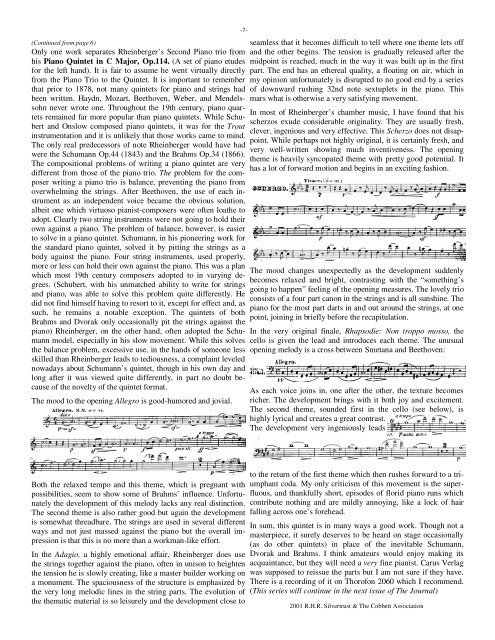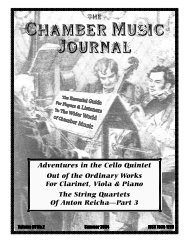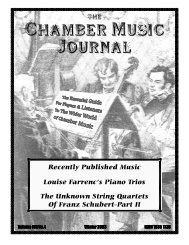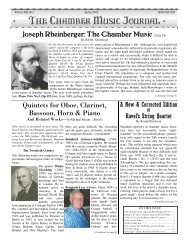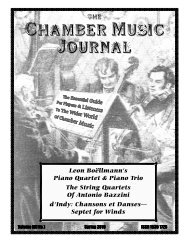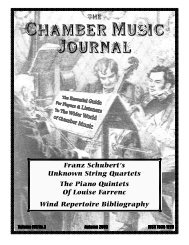Volume 12 No.4
Volume 12 No.4
Volume 12 No.4
You also want an ePaper? Increase the reach of your titles
YUMPU automatically turns print PDFs into web optimized ePapers that Google loves.
(Continued from page 6)<br />
Only one work separates Rheinberger’s Second Piano trio from<br />
his Piano Quintet in C Major, Op.114. (A set of piano etudes<br />
for the left hand). It is fair to assume he went virtually directly<br />
from the Piano Trio to the Quintet. It is important to remember<br />
that prior to 1878, not many quintets for piano and strings had<br />
been written. Haydn, Mozart, Beethoven, Weber, and Mendelssohn<br />
never wrote one. Throughout the 19th century, piano quartets<br />
remained far more popular than piano quintets. While Schubert<br />
and Onslow composed piano quintets, it was for the Trout<br />
instrumentation and it is unlikely that those works came to mind.<br />
The only real predecessors of note Rheinberger would have had<br />
were the Schumann Op.44 (1843) and the Brahms Op.34 (1866).<br />
The compositional problems of writing a piano quintet are very<br />
different from those of the piano trio. The problem for the composer<br />
writing a piano trio is balance, preventing the piano from<br />
overwhelming the strings. After Beethoven, the use of each instrument<br />
as an independent voice became the obvious solution,<br />
albeit one which virtuoso pianist-composers were often loathe to<br />
adopt. Clearly two string instruments were not going to hold their<br />
own against a piano. The problem of balance, however, is easier<br />
to solve in a piano quintet. Schumann, in his pioneering work for<br />
the standard piano quintet, solved it by pitting the strings as a<br />
body against the piano. Four string instruments, used properly,<br />
more or less can hold their own against the piano. This was a plan<br />
which most 19th century composers adopted to in varying degrees.<br />
(Schubert, with his unmatched ability to write for strings<br />
and piano, was able to solve this problem quite differently. He<br />
did not find himself having to resort to it, except for effect and, as<br />
such, he remains a notable exception. The quintets of both<br />
Brahms and Dvorak only occasionally pit the strings against the<br />
piano) Rheinberger, on the other hand, often adopted the Schumann<br />
model, especially in his slow movement. While this solves<br />
the balance problem, excessive use, in the hands of someone less<br />
skilled than Rheinberger leads to tediousness, a complaint leveled<br />
nowadays about Schumann’s quintet, though in his own day and<br />
long after it was viewed quite differently, in part no doubt because<br />
of the novelty of the quintet format.<br />
The mood to the opening Allegro is good-humored and jovial.<br />
-7-<br />
seamless that it becomes difficult to tell where one theme lets off<br />
and the other begins. The tension is gradually released after the<br />
midpoint is reached, much in the way it was built up in the first<br />
part. The end has an ethereal quality, a floating on air, which in<br />
my opinion unfortunately is disrupted to no good end by a series<br />
of downward rushing 32nd note sextuplets in the piano. This<br />
mars what is otherwise a very satisfying movement.<br />
In most of Rheinberger’s chamber music, I have found that his<br />
scherzos exude considerable originality. They are usually fresh,<br />
clever, ingenious and very effective. This Scherzo does not disappoint.<br />
While perhaps not highly original, it is certainly fresh, and<br />
very well-written showing much inventiveness. The opening<br />
theme is heavily syncopated theme with pretty good potential. It<br />
has a lot of forward motion and begins in an exciting fashion.<br />
The mood changes unexpectedly as the development suddenly<br />
becomes relaxed and bright, contrasting with the “something’s<br />
going to happen” feeling of the opening measures. The lovely trio<br />
consists of a four part canon in the strings and is all sunshine. The<br />
piano for the most part darts in and out around the strings, at one<br />
point, joining in briefly before the recapitulation.<br />
In the very original finale, Rhapsodie: Non troppo mosso, the<br />
cello is given the lead and introduces each theme. The unusual<br />
opening melody is a cross between Smetana and Beethoven:<br />
As each voice joins in, one after the other, the texture becomes<br />
richer. The development brings with it both joy and excitement.<br />
The second theme, sounded first in the cello (see below), is<br />
highly lyrical and creates a great contrast.<br />
The development very ingeniously leads<br />
Both the relaxed tempo and this theme, which is pregnant with<br />
possibilities, seem to show some of Brahms’ influence. Unfortunately<br />
the development of this melody lacks any real distinction.<br />
The second theme is also rather good but again the development<br />
is somewhat threadbare. The strings are used in several different<br />
ways and not just massed against the piano but the overall impression<br />
is that this is no more than a workman-like effort.<br />
In the Adagio, a highly emotional affair, Rheinberger does use<br />
the strings together against the piano, often in unison to heighten<br />
the tension he is slowly creating, like a master builder working on<br />
a monument. The spaciousness of the structure is emphasized by<br />
the very long melodic lines in the string parts. The evolution of<br />
the thematic material is so leisurely and the development close to<br />
to the return of the first theme which then rushes forward to a triumphant<br />
coda. My only criticism of this movement is the superfluous,<br />
and thankfully short, episodes of florid piano runs which<br />
contribute nothing and are mildly annoying, like a lock of hair<br />
falling across one’s forehead.<br />
In sum, this quintet is in many ways a good work. Though not a<br />
masterpiece, it surely deserves to be heard on stage occasionally<br />
(as do other quintets) in place of the inevitable Schumann,<br />
Dvorak and Brahms. I think amateurs would enjoy making its<br />
acquaintance, but they will need a very fine pianist. Carus Verlag<br />
was supposed to reissue the parts but I am not sure if they have.<br />
There is a recording of it on Thorofon 2060 which I recommend.<br />
(This series will continue in the next issue of The Journal)<br />
2001 R.H.R. Silvertrust & The Cobbett Association


